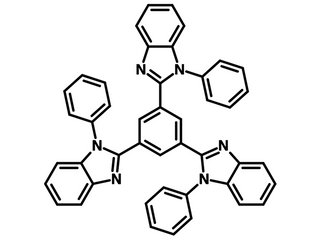TPBi, ETL material for optoelectronic devices
Low price and available online for fast and secure dispatch, Sublimed ≥99.0%, Unsublimed ≥98.0%
Overview | Specifications | Pricing and Options | MSDS | Literature and Reviews
2,2',2''-(1,3,5-Benzinetriyl)-tris(1-phenyl-1-H-benzimidazole), TPBi (CAS number 192198-85-9), being electron deficient, is normally used as electron transport layer material in optoelectronic devices. Having a low LUMO energy level (2.7 eV), TPBi is also used as host material for both fluorescent and phosphorescent light emitting systems.
In some cases, TPBI is used to replace CBP (HBL)/Alq3 (ETL) to simplify the device structure for its excellent electron transporting and also its hole blocking abilities with very deep HOMO energy level (HOMO = 6.2/6.7 eV). It has also been reported that TPBi could be used as electron injection layer material between Alq3 (ETL) and Cs2O3/Al (electrode). It suggested that TPBI thin layer at the Alq3/Cs2O3 interface facilitates the electron injection and is also involved with hole-blocking and exciton confinement [3].
TPBi from Ossila was used in the high-impact paper (IF 15.88), Suppressing Efficiency Roll-Off at High Current Densities for Ultra-Bright Green Perovskite Light-Emitting Diodes, C. Zou et al., ACS Nano, 14, 6076−6086 (2020); DOI: 10.1021/acsnano.0c01817; and paper (IF 29.4), Single-Layer Blue Organic Light-Emitting Diodes With Near-Unity Internal Quantum Efficiency, O. Sachnik et al., Adv. Mater., 35 (26), 2300574 (2023); DOI: 10.1002/adma.202300574.
General Information
| CAS number | 192198-85-9 |
|---|---|
| Chemical formula | C45H30N6 |
| Molecular weight | 654.76 g/mol |
| Absorption | λmax 305 nm in THF |
| Fluorescence | λem 370 nm in THF |
| HOMO/LUMO | HOMO 6.2/6.7 eV, LUMO 2.7 eV [1, 2] |
| Synonyms | 2,2',2"-(1,3,5-Benzinetriyl)-tris(1-phenyl-1-H-benzimidazole) |
| Classification / Family |
Benzimidazole derivatives, Electron transport layer materials (ETL), Electron injection layer materials (EIL), Hole blocking layer materials (HBL), Fluorescent and phosphorescent host materials. Light-Emitting Diodes, Organic electronics |
Product Details
| Purity |
Sublimed* >99.5% Unsublimed* >98.0% |
|---|---|
| Melting point | 272 - 277 °C (lit.) |
| Color | White Powder |
*Sublimation is a technique used to obtain ultra pure-grade chemicals. For more details about sublimation, please refer to the Sublimed Materials.
Chemical Structure
Device Structure(s)
| Device structure | ITO/MoO3(1 nm)/mCP (60 nm)/mCP:TPBi:Ir(tfmppy)2(tpip)* (20 nm, 1:1, 6 wt%)/TPBi (15 nm)/TPPhen:W2(hpp)4* (45 nm, 12 wt%)/Al (100 nm) [2] |
|---|---|
| Color | Green |
| Max. EQE | 20.8% |
| Max. Current Efficiency | 72.9 cd/A |
| Max. Power Efficiency | 66.3 lm W−1 |
| Device structure | ITO/PEDOT:PSS/PFO:MEH-PPV (1.0 wt%)/TPBi/LiF/Al [4] |
|---|---|
| Color | White |
| Max. Luminance | 7,560 cd/m2 |
| Max. Current Efficiency | 7.8 cd/A |
Pricing
| Grade | Order Code | Quantity | Price |
|---|---|---|---|
| Sublimed (>99.5% purity) | M651 | 250 mg | £210 |
| Unsublimed (>98.0% purity) | M652 | 500 mg | £220 |
| Sublimed (>99.5% purity) | M651 | 500 mg | £330 |
| Unsublimed (>98.0% purity) | M652 | 1 g | £350 |
| Sublimed (>99.5% purity) | M651 | 1 g | £520 |
MSDS Documentation
Literature and Reviews
- Highly efficient single-layer dendrimer light-emitting diodes with balanced charge transport, T. D. Anthopoulos et al., Appl. Phys. Lett., 82, 4824 (2003); doi: 10.1063/1.1586999.
- High efficiency green phosphorescent organic light-emitting diodes with a low roll-off at high brightness, J. Wang et al., Org. Electronics, 14, 2854–2858 (2013). http://dx.doi.org/10.1016/j.orgel.2013.08.006.
- Improved Hole-Blocking and Electron Injection Using a TPBI Interlayer at the Cathode Interface of OLEDs, J. Lian et al., Chin. Phys. Lett., 28, 047803 (2011). http://iopscience.iop.org/0256-307X/28/4/047803.

